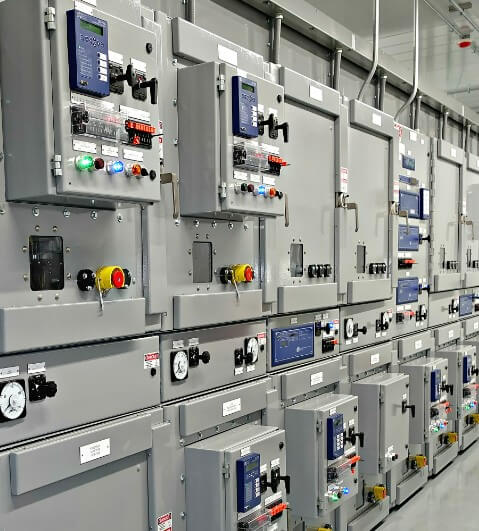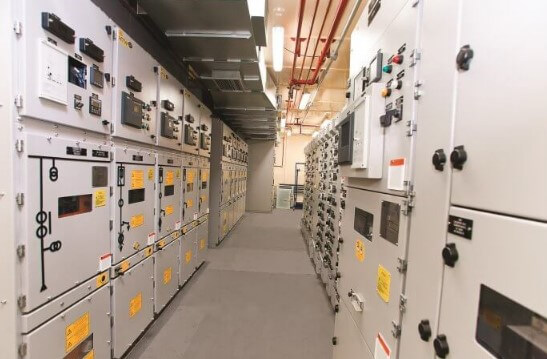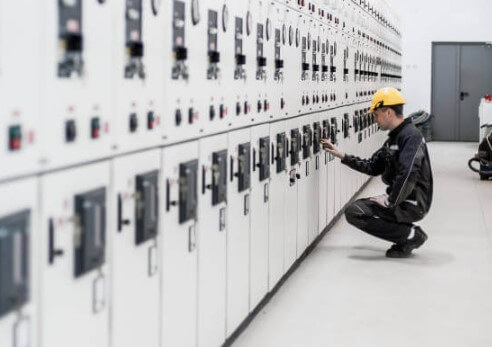Electric power management and distribution in an industrial setup is a complex yet essential process. Ensuring seamless operation and power supply to various machinery and equipment hinges on the efficient functioning of several components. Let's take a closer look at this intricate system, focusing on the critical role of electrical panels.
Industrial Power Distribution: An Overview
At its core, an industrial power distribution system is designed to facilitate safe and efficient electric power transmission. This power is typically supplied from private or public utilities, with voltages ranging from 11KV to 132KV. This high-voltage supply is toned down to a lower voltage using step-down transformers.
The stepped-down voltage, commonly referred to as low tension systems, falls within the range of 440 volts or below. This voltage is then distributed to various panels and equipment via a switchgear arrangement. This arrangement comprises electrical switches, circuit breakers, fuses, protective gear, and metering boards.

GET IN TOUCH
The ultimate solution for reliable power control! call us at 276-285-3841
There are several key components involved in the power distribution setup, including Low Tension (LT) panels, sub-LT panels, sub-distribution boards (SDB), power distribution boards (PDB), and lighting distribution boards (LDB).
Low Tension (LT) Panels
LT panels are the primary switching system for the entire power distribution scheme. They receive the power supply from various transformers and distribute it to sub-LT panels. Enclosed in metal structures, these panels are rated for 430 V, 3-phase, 50Hz three or four-wire systems. They come with a design that ensures operational safety and ease of maintenance.
One of the critical components of the LT panel is the Air Circuit Breaker (ACB), which is responsible for making or breaking the circuit either manually or remotely under normal conditions. In the event of a fault, ACB automatically breaks the circuit. They are equipped with microprocessor systems to protect against overload, earth faults, and short circuits.
Bus Bars and Connections
High-conductivity copper-made bus bars form an integral part of the LT panel. They collect the supply from transformer terminals and distribute it to various components in the panel. Depending on the supply source, they can be positioned at either the top or bottom of the panel.
Sub-LT Panels
Sub-LT panels are similar to LT panels but have a somewhat lower rating. They are located in particular sections of an industry, such as the assembly or dispatching sections. These panels distribute power to the SDBs and are designed to switch some loads to a Diesel Generator (DG) supply when the power supplied by utilities is insufficient.

GET IN TOUCH
The ultimate solution for reliable power control! call us at 276-285-3841
Sub-Distribution Boards (SDBs)
SDBs are designed to receive power from sub-LT or main LT panels and distribute it to various power-demanding machinery and power distribution boards (PDBs). They are equipped with ACB or MCCB to receive power distributed through outgoing MCCBs or Switch-Disconnect-Fuses (SDFUs).
Power Distribution Boards (PDBs)
PDBs are engineered to distribute power to various machines and equipment. They are equipped with short circuit and overload protection systems and have different protective relays that can trip the circuit breakers against various faults. These boards receive power from multiple SDBs and supply it to the adjacent loads.
Lighting Distribution Boards (LDBs)
LDBs are the final switchboards in the electrical wiring and installation process. They are located at small electrical load switching areas, including lighting, air conditioners, small motor switching, and distribution boards for plugging portable devices.

GET IN TOUCH
The ultimate solution for reliable power control! call us at 276-285-3841
Conclusion
Electric power distribution in an industrial setting involves an intricate system of panels, boards, and switches. Understanding these components and their functions is crucial to maintaining efficient and uninterrupted operation of machinery and equipment in the industry.
Expanding upon this topic, it's worth delving deeper into the importance of regular maintenance and upgrades in industrial power distribution systems. These systems are the lifeblood of modern manufacturing facilities, and any disruptions can result in significant financial losses.
Maintenance is key to ensuring the longevity and reliability of these systems. Regular inspections, cleaning, and testing of components like circuit breakers, fuses, and bus bars are essential to detect and address potential issues before they escalate into costly failures.
Moreover, technological advancements have led to the development of smart panels and monitoring systems. These innovations enable real-time monitoring of power consumption, voltage fluctuations, and equipment performance. By investing in such technologies, industrial facilities can optimize their energy usage, reduce downtime, and minimize operational costs.
Additionally, as industries continue to evolve and expand, the demand for electricity grows. Upgrading power distribution systems to accommodate higher loads and ensure scalability is crucial. This may involve replacing outdated equipment, increasing the capacity of transformers, or enhancing the protective measures to meet evolving safety standards.
Environmental considerations also play a significant role in industrial power distribution. Many industries are increasingly adopting sustainable practices, including the integration of renewable energy sources into their power supply. This transition requires careful planning and adaptation of power distribution systems to incorporate solar panels, wind turbines, or other renewable sources seamlessly.
Furthermore, backup power solutions, such as uninterruptible power supplies (UPS) and generators, should be integrated into the distribution network to safeguard against unexpected power outages. These backup systems ensure that critical operations can continue without disruption, preventing costly downtime and production losses.
While industrial power distribution may appear complex, it is a vital aspect of modern manufacturing. Ensuring the efficiency, reliability, and sustainability of these systems through regular maintenance, technological advancements, and environmental considerations is essential for the success and competitiveness of industrial facilities. As industries continue to evolve, so too must their power distribution infrastructure to meet the challenges and opportunities of the future.
Our Expert Services
Swartz Engineering provides top-quality products to achieve our customers' needs. We also make sure our products work reliably and safely. Our products include:
- Type 76 DC Relay
- Type 82 DC Relay
- Swartz Engineering’s Type 64 Ground Relay
- Type 32 Reverse Current Relay
- Type 150 DC
- CSM Shield Monitor
- Metal Oxide Surge Arrestors
- Transducers
- MVIS SL Slim-line Contactor
- Fully-tested Power Control Rooms
- Swartz Engineering’s Portable Substations
Contact Us
If you have a need for regular mobile power solutions, backups, or temporary power solutions, Swartz Engineering can deliver the crucial systems in a custom build for your needs. Contact us today to learn more about our mobile substation designs.
